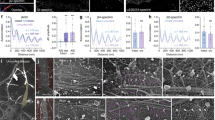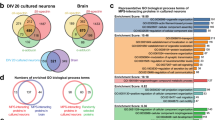Summary
The three-dimensional structure of the neurofilamentous network of the giant axon of the squid has been investigated by stereo electron microscopy and optical image analysis. The neurofilamentous network with its structural associations intact was partially purified by means of extraction of extruded axoplasm in a physiological buffer. The authors employed a “double-grid mounting technique” for critical point drying of axoplasm which provides high contrast preparations having great depth suitable for the analysis of spatial relations. There is a striking improvement in the perception of the continuity and three-dimensionality of the network, particularly in thin areas produced by teasing apart the specimen prior to mounting. Sidearms and cross-bridges are readily identifiable.
In 1-μm thick preparations of the extracted axoplasm the neurofilamentous network is composed of two structural entities: (i) long 10-nm wide filaments approximately parallel with the long axis of the extracted axoplasmic cylinder (axial), (ii) and short, finer filaments projecting from them as sidearms or crossbridges (radial). Optical analysis of micrographs of extracted axoplasm indicates that the radial filamentous components of the neurofilamentous network are distributed predominantly in the range of 32° to 67° with respect to the long axis of the axial filaments. We tentatively assign the 220,000 mol wt peptide observed by SDS-PAGE in this preparation to the radial filaments and the 68,000 mol wt peptide to the axial filaments.
Similar content being viewed by others
References
Allen RD, Metuzals J, Tasaki I (1981) Fast axonal transport in the squid giant axon. Biol Bull 161:303
Anderson TF (1956) Electron microscopy of microorganisms. In: Oster G, Pollister AW (eds) Physical techniques in biological research, Vol III, Cells and Tissues. Academic Press, New York, pp 177–240
Bloodgood RA, Rosenbaum JL (1976) Ultrastructure observations on the squid giant axon and associated Schwann cell sheath. Biol Bull 151:402 (Abstr)
Ellisman MH, Porter KR (1980) Microtrabecular structure of the axoplasmic matrix: Visualization of cross-linking structures and their distribution. J Cell Biol 87:464–479
Geisler N, Weber K (1981) Self-assembly in vitro of the 68,000 molecular weight component of themammalian neurofilament triplet proteins into intermediate-sized filaments. J Mol Biol 151:565–571
Gilbert DS, Newby B, Anderton B (1975) Neurofilament disguise, destruction and discipline. Nature (Lond) 256:586–589
Grubb DT, Keller A, Groves GW (1972) Origin of contrast effects in the electron microscopy of polymers. Part I: Polyethylene single crystals. J Mat Sci 7:131–141
Hodge AJ, Adelman WJ Jr (1980) The neuroplasmic network in Loligo and Hermissenda neurons. J Ultrastruct Res 70:220–241
Johnson MW, Horne RW (1970) Some observations on the relative dehydration rates of negative stains and biological objects. J Microsc 91:197–202
Joshi CJ, Chapman GD, Sancton RW (1979) A Fourier transform technique for quantitative assessment of ion tracks in cellulose nitrate film. J Appl Phys 50:3096–3101
Krishnan N, Kaiserman-Abramof IR, Lasek RJ (1979) Helical substructure of neurofilaments isolated from Myxicola and squid giant axons. J Cell Biol 82:323–335
Lasek RJ, Krishnan N, Kaiserman-Abramof IR (1979) Identification of the subunit proteins of 10 nm neurofilaments isolated from axoplasm of squid and Myxicola giant axons. J Cell Biol 82:336–346
Metuzals J (1969) Configuration of a filamentous network in the axoplasm of the squid (Loligo pealei L.) giant nerve fiber. J Cell Biol 43:480–505
Metuzals J, Clapin DF (1981) Modes of crosslinking in neurofilament protein isolated from squid gian taxon: electron microscopic evidence for paracrystalline arrays. Biol Bull 161:308 (Abstr)
Metuzals J, Izzard CS (1969) Spatial patterns of threadlike elements in the axoplasm of the giant nerve fiber of the squid (Loligo pealei L.) as disclosed by differential interference microscopy and byelectron microscopy. J Cell Biol 43:456–479
Metuzals J, Lasek RJ, Hodge AJ (1980a) Stereo electron microscopy of the neuro filamentous network prepared by a sandwich technique. The second international congress on cell biology, Berlin (West). Eur J Cell Biol 22:380 (Abstr)
Metuzals J, Terakawa S, Tasaki I (1980b) The axolemma-ectoplasm complex investigated in desheathed squid giant axons. In: Brederoo P, de Priester W (eds) Proceedings of the Seventh European Congresson Electron Microscopy, The Hague. Seventh European congress on electron microscopyfoundation, Leiden, The Netherlands, 2:12–13
Metuzals J, Montpetit V, Clapin DF (1981a) Organization of the neurofilamentous network. Cell Tissue Res 214:455–482
Metuzals J, Tasaki I, Terakawa S, Clapin DF (1981b) Removal of the Schwann sheath from the gian taxon of the squid: an electron microscopic study of the desheathed axolemma and of associated axoplasmic structures. Cell Tissue Res 221:1–15
Metuzals J, Clapin DF, Tazaki I (1982) The axolemma-ectoplasm complex of squid giant axon. In: Chang DC, Tasaki I, Adelman WJ Jr, Leuchtag HR (eds) Structure and function in excitable cells. Plenum Press, New York (in press)
Morris JR, Lasek RJ (1979) Differential solubilities of cytoskeletal proteins in squid axoplasm. Biol Bull 157:384 (Abstr)
Morris JR, Lasek RJ (1982) Stable polymers of the axonal cytoskeleton: The axoplasmic ghost. J Cell Biol 92:192–198
Nankivell JF (1963) The theory of electron stereo microscopy. Optik 20:171–198
Neville DM (1971) Molecular weight determination of protein-dodecyl sulfate complexes by gel electrophoresis in a discontinuous buffer system. J Biol Chem 246:6328–6334
Reynolds E (1963) The use of lead citrate at high pH as an electron-opaque stain in electron microscopy. J Cell Biol 17:208–212
Rice RV, Roslansky PF, Pascoe N, Houghton SM (1980) Bridges between microtubules and neurofilaments visualized by stereo electron microscopy. J Ultrastruct Res 71:303–310
Roslansky PF, Cornell-Bell A, Rice RV, Adelman WJ Jr (1980) Polypeptide composition of squid neurofilaments. Proc Natl Acad Sci USA 77:404–408
Rubinson KA, Baker PF (1979) The flow properties of axoplasm in a defined chemical environment: influence of anions and calcium. Proc R Soc Lond B 205:323–345
Unwin PNT (1974) Electron microscopy of the stacked disk aggregate of Tobacco Mosaic virus protein. II. The influence of electron irradiation on the stain distribution. J Mol Biol 87:657–670
Willard M, Simon C (1981) Antibody decoration of neurofilaments. J Cell Biol 89:198–205
Zackroff RV, Goldman RD (1980) In vitro reassembly of squid brain intermediate filaments (neurofilaments): Purification by assembly-disassembly. Science (Wash. DC) 208:1152–1155
Author information
Authors and Affiliations
Rights and permissions
About this article
Cite this article
Metuzals, J., Clapin, D.F. & Chapman, G.D. Axial and radial filamentous components of the neurofilamentous network. Cell Tissue Res. 223, 507–518 (1982). https://doi.org/10.1007/BF00218472
Accepted:
Issue Date:
DOI: https://doi.org/10.1007/BF00218472




